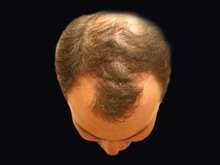Health Topics
-
Healthy Living
-
|
|
September 2010
|
| The Bald and the Beautiful |
| Dr. Parag Sahasrabudhe |
|
 |
Hair loss and hair fall are two separate things. Hair fall is a natural daily occurrence. Even the very hairs on your head are numbered - the human head contains over 1,00,000 hairs and one normally sheds 100 to150 hairs a day! So don’t pull out your hair in desperation – your hair fall could be pretty normal, after all. |
Be Bald
Baldness is often blamed on poor blood circulation in the scalp, vitamin deficiencies, dandruff, and even excessive hat-wearing. All of these theories have been disproved though. In both men and women, the common form of hair loss is technically called androgenetic alopecia. In this condition, hormonal imbalance, combined with hereditary predisposition produces thinning of hair and pattern baldness. Less common causes
- includeHigh fever
- Severe infection
- Diet
- ertain medications
- Birth control pills
- Thyroid disease
- Cancer treatment:
A Pattern To It
Male pattern baldness usually begins with a receding hairline and thinning at the crown, and continues to progress over a lifetime.
Female pattern baldness usually consists of thinning across the top of the scalp, though the frontal hairline is preserved.
Grafting
Topical or oral medications may benefit some people with early to moderate hair loss. The doctor may combine this with advanced surgical techniques at times. The most popular technique is of micro follicular hair grafting, which provides the most natural looking hairline. This technique can be applied to the scalp, eyebrows, eyelashes, beard, moustache and sideburns.
- A strip of hair-bearing skin is harvested from that area of the scalp that never becomes bald in pattern baldness, like the back of the head.
- The strip is divided into small units (grafts), each containing one, two or three hair - the follicular units.
- Micro or mini follicles of hair are dissected out gently and meticulously undermicroscope by a team of well trained surgeons.
- These hair follicles are then transplanted in bald areas by stab incisions at the proposed site for grafting.
- Great precaution is taken to ensure the correct angle of transplantation so as to give natural look to new hair.
- The whole process may involve transplanting up to 1500- 2500 hair follicles in a single sitting! That’s a lot of pricks on your head.
The entire procedure is performed under local anaesthesia and the patient goes home on the same day.
Dress It Up
- After the small surgery, a dressing is placed on the grafted area to keep it protected.
- Most people do not have significant pain after surgery. Pain, if any, is mostly controlled by simple painkillers taken orally.
- Some itching and swelling occurs, but is generally mild.
- The dressing is removed after two days. The patient can go back to work two days after surgery.
Overhead bath is allowed on the fifth day.
Life After Transplant
- The donor site at the back of the head is not visible, as scars get hidden in the hairline.
- The transplanted hair falls out in about two weeks.
- New hair generally begins to grow in about three months. It will continue to grow half-inch per month for the rest of your life (yes, you can throw away that wig).
- This transplanted hair can be combed like normal hair and are permanent. You can wash them, trim them, style them anyway you like.
- There are no serious complications. Very rarely, bleeding might continue from the recipient or donor site. This would happen only if you have a blood clotting problem. Pain is minor and can be well controlled with analgesics.
- Once the new hair has grown, a next session may be performed to improve the density of the hair, if required.
- The new look will be evident six months after surgery.
|
 |
Dr. Parag Sahasrabudhe is Consultant Plastic Surgeon at Jehangir Hospital, Pune, Apollo Hospitals Group |
|
|